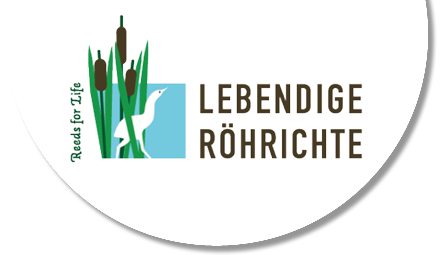Influence of the Coypu
One important measure in the EU LIFE “Reeds for Life” project is to control and remove the coypu from the project area. The coypu is an invasive species and endangers the biological diversity and thus the value of the protected area.
At the start of controlling an invasive species, you have to clarify what damage it is responsible for and what measures are necessary to combat the species.
The eating habits of the coypu on the Bienen Old Rhine is a definitively proven factor for the considerable decline in reed plants. The reed populations being eating causes damage in many ways. Firstly, the plants’ growing points are eaten, which means that the plants cannot send out new shoots and die off. As a consequence, the shallow bank zones are no longer firmed up by the mass of roots and the level drops. As a result, areas for the natural repopulation of reeds and the muddy corridor habitat are lost.
As a result of the destruction of the reeds and the bank zones, the species diversity in the area is actually endangered. Several bird species as well as many other animal species are affected. For example, from the large group of insects, the aquatic leaf beetles (Donaciinae) and some owlet moths (Noctuidae) are reliant on reeds.
In other areas it has been proved that coypu also damage floating leaf plants by digging up and eating the rhizomes. A sharp decline of floating leaf plants has also been documented in the project area; the involvement of the coypu in this development is highly likely.
For the black tern, which is at risk of extinction, another factor comes into play in addition to the destruction of its habitat. In the project area, the black tern breeds on nest rafts. In recent years, it has often been proved that the coypu climb onto these rafts and, as a consequence, the clutches of eggs are destroyed.
And the highly endangered fish species bittering, which is supposed to be protected on the Bienen Old Rhine, is directly affected by the coypu activity. Because the bitterling lays its eggs in mussels. And these mussels are also eaten by coypu.
Controlling the Coypu
Catching and killing is currently the only effective and animal-friendly method of ensuring the removal of the coypu from the protected area. Other approaches, such as catching and castrating, hormonal sterilisation or large-scale fencing of an area are hard to put into practice and are not successful enough. In addition, they are also associated with stresses for the animals, some of them severe.
The Nature Conservation Centre has therefore decided on catching in live traps and killing within the shortest possible time. A detailed procedure is being drawn up for this so that the suffering and pain for the coypu is kept to a minimum.
Special traps have been developed for catching in which the coypu cannot injure themselves and that are in protected surroundings. As soon as an animal is trapped, a specially trained hunter is informed by transmitter (automatic game transmitter) and seeks out the trap as quickly as possible. The animal is then killed quickly and painlessly in the trap. With the help of the automatic game transmitter it is possible to minimise disruptions in the protected area and, at the same time, satisfy the requirements of animal protection and the Trapping Ordinance.
To interrupt the quick reproduction of the coypu and, overall, to have to kill as few animals as possible, the number of coypus should be reduced as quickly as possible. As well as using live traps, individual rough shooting exercises with hunters and dogs will also be carried out in the initial phase in the winter.
Use
The coypu that are killed will be used in various ways. Some will remain in the protected area and will be used there as a natural source of food for scavengers. Some will be made available to local zoos as animal feed. Some of the high-quality winter pelts will be sent to a fur processing plant using ecological criteria.
Necessity
Since the coypu reproduce very quickly, the risk of an irrevocable negative change to the unique protected area is very high. There is no alternative for the animal species ecologically tied to reeds. In this case, removal of the coypu in the project area is the only way of conserving the valuable habitats and their communities of species.
In view of this damage and these risks, the complete removal of the coypu within the project area and the permanent prevention of migration to the project area is is a necessary measure for the “Bienener Altrhein, Millinger und Hurler Meer und Empeler Meer” conservation area without which the value of the area for biological diversity cannot be preserved.






